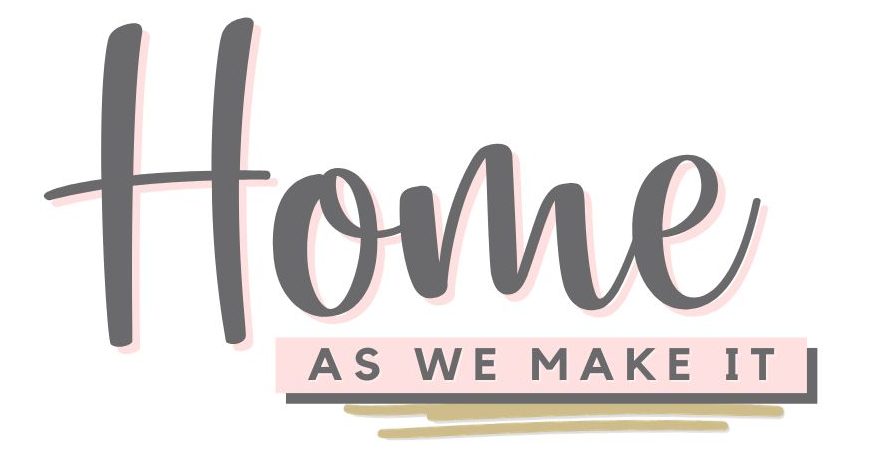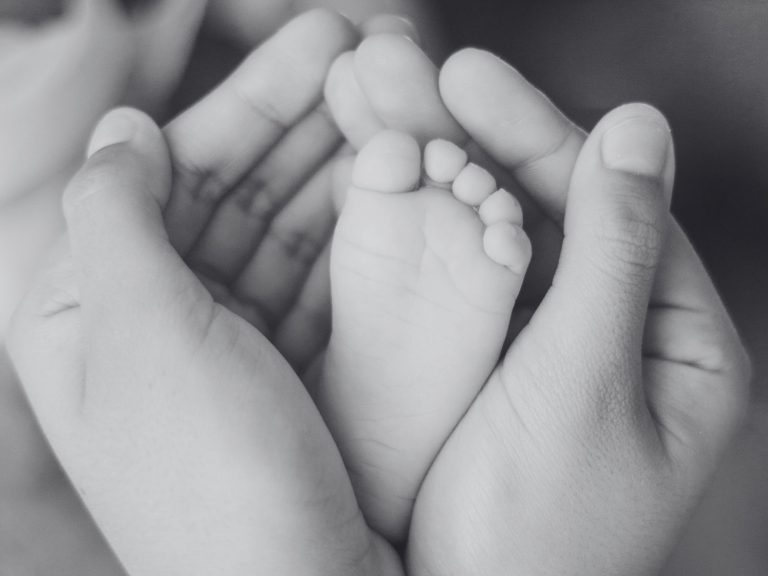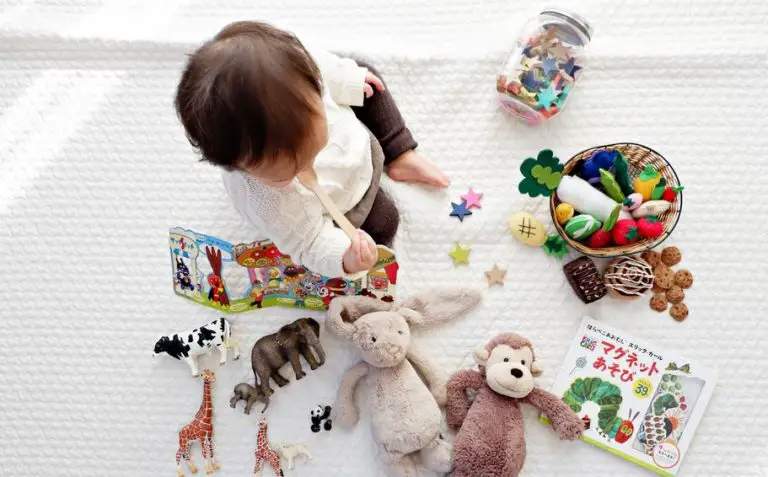4 Months Baby Development. What You Need To Know
5-month-old baby development →
Note: This post may contain affiliate links, which means if you buy from my link I might make a small commission. This does not affect the price you pay. See the full affiliate disclosure here.
Turning 4 months old is a huge milestone for both baby and mom. There is so much going on, you’ve noticed so many new skills and it’s all part of the 4 months baby development.
So put the baby for a nap and see exactly what I’m talking about.
What to expect from 4-month-old babies?

Physical growth
By the 4 months mark, your baby should have doubled their birth weight. From now on, they will start growing in height and weight a little slower than before.
And that’s completely normal. Otherwise, by turning 1-year-old they’ll be as high as a first grader.
On average, in the last month, 4-month-old babies grow about 2-4 cm (1-2 in) and gain around 500 to 900 gr (1-2 lb).
Feeding
If your baby is formula-fed, your pediatrician may advise you to start feeding the baby solid food. It comes in the form of pureed vegetables and fruits and semi-liquid cereal.
If you’re a first-time mom this could sound really scary. I remember being afraid that my baby would choke and watched tons of different baby’s first aid videos. I also didn’t like the taste of the food at all and felt sorry for the baby for having to eat this (I got over this one pretty quickly though).
While the chance of your baby choking on food is extremely low, if you want to have some peace of mind you may want to watch a baby first aid video if you haven’t done so already.
Your pediatrician should also advise you on the exact scheme you need to use with your baby, i.e. which fruits and veggies are introduced first, what amount should you offer your baby.
On the other hand, if your baby is breastfed, it is highly recommended that you wait until the 6-month mark before introducing solids.
Sleep
Over the last month, you’ve probably established some kind of a routine.
Your baby naps and feeding times start becoming predictable. They let you sleep through (most of) the night. They fall asleep easier because the colic is finally over.
And then comes the first of the notorious sleep regressions.
Some signs that your baby is experiencing a sleep regression include:
- Refuses to nap or sleep
- Wakes up more frequently at night
- Becomes irritated more easily
- Wants to feed more often
It is important to note that sleep regressions are natural and part of your 4 months baby development. Therefore, there is no “cure” for it. It’s just another period that will pass before you know it.
In the meantime, make sure you try to continue with your baby’s routine as usual.
As for the light at the end of the tunnel, at 4 months your baby is developed enough to start learning to soothe themselves. This will help both your baby and you to finally start sleeping through the night if you haven’t already.
Motor skills
At 4 months babies are starting to become more active. And with this comes their new ability to roll over from front to back. Make sure you encourage them in your exercise routine and help them until they master this new skill.
However, if you used to swaddle your baby, now would be a good time to stop.
Swaddling a baby that can turn over on their own poses a great risk to them. Instead, try opting for a soft and comfy sleeping bag.
On a second note, your baby should now be able to hold their head steadily. If they are still wobbling their head when held in a standing position, be sure to consult your pediatrician.
How do you play with your 4-month-old baby?

Peek-a-boo
At this stage, infants start to learn that when something is hidden it’s not really gone. Thus, it’s the perfect time to start playing peek-a-boo.
Alternatively, you can show them a small toy and then hide it under a handkerchief. Show them how to uncover it and they’ll soon try to do it themselves.
Hanging toys and mobiles
Your baby is finally old enough to start reaching for toys.
Encourage them by hanging toys and mobiles over their crib or stroller. You can also hold a toy or a rattle in front of them or leave it in their immediate surroundings so they can reach for it and grab it.
Introduce new toys
Pick a selection of lightweight and colorful toys and rattles your baby can “play” with. Go for textured or musical toys, as well as toys designed specifically to be easily held by infants.
You can also get a baby comforter that they can hug and explore. Once they are used to the comforter I could help them soothe themselves and fall asleep easier.
Keep exercising
Your baby is not over the rapid muscle development phase, so daily exercises are still a must in your routine.
Since they will start sitting up soon you can try lifting them to a sitting position.
To do so put the baby on their back, let them hold your thumbs, and place your index finger over their palm. If they try to pull up, help them to a sitting position, hold them for 1-2 seconds and then push them back down.
It is important that your baby initiates the pull and keeps his head and shoulders up when lifted. Otherwise, they are not ready for this exercise just yet.
Mirror time
Babies love all faces. Including their own. So let them explore “the baby in the mirror” while holding them.
You could also place a mirror in front of them during tummy time. However, remember that your baby is now reaching out for things. So be sure to support the mirror at all times and don’t leave the baby alone with it.
Encourage communication
It’s not long before you start hearing the sweet sound of “mama” and “dada”. But before this happens, you should encourage baby talk as much as possible.
Don’t worry, it’s a lot simpler than it sounds. Here are a few ways to do it:
- Imitate the sounds your baby makes. Pronounce them as you hear them to encourage them to coo and babble.
- Tell the baby what are you doing or going to do. For example “I’m going to change your diaper. Here’s the nappy cream.“
- Ask questions and answer them. For example “What’s that sound? It’s the cat meowing.” or “Who’s ready for a bath? Baby Kathy is ready for her bath.” Also name the things your baby shows interest in.
- Stop and listen when they “talk” to you. Encourage two-way communication by listening, reacting, and responding to your baby’s babbles.
Show them the world
When going for a walk with your stroller, you can now turn the baby facing forward. They will be absolutely astonished by the whole new world in front of them.
Keep in mind, however, that it is still not recommended for a 4-months-old baby to stay in a sitting position for prolonged periods of time.
4-months baby development milestones

Before we continue, let’s stress again that all babies are different. With this said, the milestones listed below are intended for informational purposes only. Before stressing over a missed milestone, please consult your pediatrician first.
Now without further ado, here is what you can expect from your baby in terms of 4 months baby development milestones.
- Recognizes familiar people and objects from a distance.
- Rolls over front to back.
- Improved hand-eye coordination by reaching for a toy they have noticed.
- Holds light baby toys on it’s own.
- Holds their head and chest up.
- Does not wobble head while in a standing position.
- Brings hands and toys to mouth.
- Starts to learn cause and effect (they start crying, you rush to pick them up).
- Enjoy play time and may cry when playing stops.
- Tries to mimic language (cooing).
- Tries to mimic facial expressions (smile and frown)
When to worry?
The 4-months mark is usually the point when any physical or cognitive development issues become more apparent. If you have any concerns be sure to contact your baby’s healthcare provider immediately. They can send to a specialist who will confirm or deny the diagnosis.
Some red flags that you may check for include:
- Baby has gained less than 50% of their birth weight.
- They are unable to keep their head up.
- The baby doesn’t show interest in the people around them or their faces.
- They don’t follow moving items.
- Baby doesn’t smile in response to your attention.







